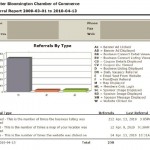Just yesterday, I was emailing a brand new Chamber member of only a few of weeks. I decided to attached their referral report – a handy-dandy report that details how many times their business information was viewed on The Chamber’s on-line directory, how many times their website link was clicked, and how many times people mapped their business location.
As a marketing person, I was really excited by what I saw in their referral report!
 This brand new Chamber member’s listing had already been viewed 212 times! Of those views, 14 people actually clicked the link taking them to the business’s website and 12 people mapped how to get to the location!
This brand new Chamber member’s listing had already been viewed 212 times! Of those views, 14 people actually clicked the link taking them to the business’s website and 12 people mapped how to get to the location!
Real-numbers, measured in real time. A marketing person’s dream-come-true, and something that every business should look at. Thanks to the referral report, this Chamber member can easily quantify the results of their Chamber membership investment in terms of marketing because, “numbers don’t lie.”
Let’s face it – most businesses feel they must advertise to get sales but often find their biggest challenge lies in calculating the return-on-investment or ROI. I’m not talking about the number of readers/listeners/viewers for a particular medium. I’m talking about whether anybody responded to their ad in terms taking some sort of action. Most have no idea what proportion of their ad-spend is wasted or how many people actually saw their ad or, more importantly, how many responded to their campaign.
Measuring your ROI on advertising definitely is challenging but there are a few fairly simple ways.
1. Design your advertising/marketing with some measurable objectives in mind or else you’ll never know if your campaign was a success or failure. Use a coupon, promotional code or even ask your customers how they heard of you. This way you can track the number who actually “converted” thanks to your campaign. If you spent $700 on a campaign but can’t attribute any sales to it – is it really a success? You won’t know unless you can measure with real numbers.
2. Define your campaign, your objectives — and be certain to track how much you’re spending on that campaign. At the very least, you need to know all three of these in addition to your end results so you can calculate your success rate.
3. Dig deep for data and take the time to crunch the numbers. This means you will need to create reporting systems that measure the information you need. Yes, it’s easy to count the number of coupons that came in, but can you also track the total of the purchases? Not only will you been able to get the number of customers who were part of the promotion, but you can also get the average total purchase. That makes it easy for you to decide if the promotion and marketing campaign should be used again.
4. Continually improve the way you measure and track your ROI. Ask a lot of “what ifs” and “I wonder…” as you’re crunching your data and you’ll be well on your way to finding new ways to improve your measurements which can lead to greater revenues and profits.
If you’re a member of The Greater Bloomington Chamber of Commerce and want to see your referral report, or if you want more information on how to become a member, call The Chamber at 812-336-6381 or e-mail info@chamberbloomington.org and we’ll email the information.
